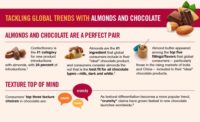Almond Board of California: Nuts About Almonds
Innova Market Insights data show almonds most prevalent in global new product development

PHOTO CREDIT: Leo Gong Photography for the Almond Board of California

PHOTO CREDIT: Leo Gong Photography for the Almond Board of California


According to new data from Innova Market Insights, almonds comprised more than 41% of the nut products introduced globally in 2020, with 12,181 new almond introductions globally.
With global consumers becoming more engaged in purchasing food products that fit into their specific lifestyle choices and address sought-after health claims, the latest findings revealed by Innova’s Global New Products Report demonstrate that almonds are a key ingredient in new introductions that are tailored to fit consumers’ specific lifestyles and health goals.
Almonds are considered a nutrient-rich snack among consumers in North America, in many countries across Europe and in Latin America. Heart-friendliness1, weight management and improved memory rank among the top health-related benefits associated with almonds in these regions. Globally, health claims are observed more frequently on introductions with almonds when compared to total food introductions.
Gluten free increased its share by 2% to maintain its position as the top health claim (26%) associated with almonds for on-pack claims, followed by vegan (18%) and high/source of protein (16%). This year a key highlight as plant-based food products become more mainstream, the report found that almonds are the number one nut for plant-based claims.
“We experienced an unprecedented year in 2020 due to the global disruptions caused by COVID-19 to the food industry. However, food developers should be encouraged by almonds’ versatility to speak to consumers’ increasing expectations for their food to address their health and lifestyle needs. Their ability to be formulated into various forms such as almond protein powder, almond flour and almond butter that can be utilized across product categories contributes to their continued standing as the world’s number one nut,” said Lu Ann Williams, Director of Innovation at Innova Market Insights.
The Global New Products Report found that almonds are the top nut in Asia-Pacific, Europe and North America, with the Middle East & Africa being the fastest growing region for almonds in 2020. Nearly 80% of all new almond product introductions were in the confectionery (22%), snacks (19%), bakery (17%), bars (14%) and cereals (8%) categories.
Confectionery is the top category for almond introductions in Europe and the Middle East & Africa, while snacks leads in Latin America and Asia-Pacific, and bars in North America. With more people working from home, the cereals category grew by 27% to move back into the top five categories, reclaiming its spot from dairy in 2019.
The fastest growing category, however, is sports nutrition with a 51% growth rate. Crunchy (7%), creamy (6%), crispy (4%), soft (2%) and smooth (2%) continue to be the top texture claims for new almond introductions.
“We are thrilled to see that consumers across the world continue to turn to almonds to help fulfill their nutritional goals and cravings, even in unprecedented times,” said Harbinder Maan, Associate Director, Trade Marketing and Stewardship at the Almond Board of California. “The future is bright for almonds and we look forward to seeing new and different opportunities arise across categories in the coming year and beyond.”
When compared ounce for ounce, almonds are the tree nut highest in vitamin E and riboflavin2, and a one-ounce serving of almonds provides 6g of power-packed protein and four grams of fiber.
Visit Almonds.com to view an infographic highlighting key data from the report.
References:
Innova Market Insights, Global New Product Introductions Report, 2020. May 2021.
Almond Board of California, 2019 Global Perceptions Study. March 2020.
1Good news about almonds and heart health. Scientific evidence suggests but does not prove that eating 1.5 ounces per day of most nuts, such as almonds, as part of a diet low in saturated fat and cholesterol may reduce the risk of heart disease. One serving of almonds (28g) has 13g of unsaturated fat and only 1g of saturated fat.
2Compared to Brazil nuts, hazelnuts, pecans, pine nuts, walnuts, cashews, macadamias and pistachios.
Looking for a reprint of this article?
From high-res PDFs to custom plaques, order your copy today!





